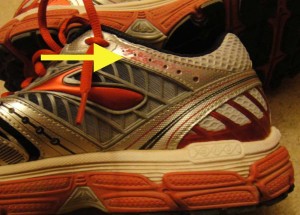 Anyone who trains for endurance sports is going to have pains and injuries; that’s a fact. What can one do to prevent overuse injuries? Stop running for one, but none of us want to do that. There are many great trainers and sports injury specialists who can help you avoid injuries and assist you in rehab when you do get injured. What other steps can one take to avoid injury? One source for answers is located on your feet; namely those expensive running shoes!
Anyone who trains for endurance sports is going to have pains and injuries; that’s a fact. What can one do to prevent overuse injuries? Stop running for one, but none of us want to do that. There are many great trainers and sports injury specialists who can help you avoid injuries and assist you in rehab when you do get injured. What other steps can one take to avoid injury? One source for answers is located on your feet; namely those expensive running shoes!
I’ve had my share of injuries through the years and though I don’t claim to be an expert, I have learned a few things by logging over 2,700 miles and burning 298,000 calories since May of 2007. Mainly, listen to what your body is telling you and also, look at what your shoes might be telling you.
About a month ago I purchased my second pair of Brooks Glycerin 9 shoes since I loved the first pair so much. It’s been an injury free 2011 (knock on wood) so why change a good thing? My first 25 miles in these shoes were like running on a cloud, never a hint of pain. This past weekend during our Saturday 8 mile run I felt a twinge of my old nemesis, plantar faciitis. My left heel was very sore the remainder of the day and also the next. Other than trying to keep up with Jenn what could have brought this back? Next time I laced up my shoes I happened to notice scuff marks on the right shoe, adjacent to my right ankle. Apparently I had fallen into some sort of weird gait which had me kicking my right ankle each time my left leg went forward. I was not aware of this during the run but recalling my plantar faciitis injury days I realize that this was in indication of an aberration in my gait.
I know some running gurus say that one cannot make changes to your natural gait; however I disagree with this thought. I ran yesterday and focused on not dragging my left foot alongside my right ankle. I concentrated on squaring my hips forward and actually watched my feet strike the ground much of the time, noticing that the left foot does not plant squarely as consistent as the right foot does. What did I accomplish? I had no pain in my left foot either during or after the run. Is that injury gone for good? I can’t guarantee that but I am alert to abnormalities in my stride and will be on guard in the future.
I concentrated on squaring my hips forward and actually watched my feet strike the ground much of the time, noticing that the left foot does not plant squarely as consistent as the right foot does. What did I accomplish? I had no pain in my left foot either during or after the run. Is that injury gone for good? I can’t guarantee that but I am alert to abnormalities in my stride and will be on guard in the future.
Another area of interest regarding shoes; look at the wear pattern on the bottom. The elaborate sole designs of modern running shoes make it easy to spot variations between your two feet, another possible clue to the prevention of injuries.
Run safely,
Ken

You must be logged in to post a comment.